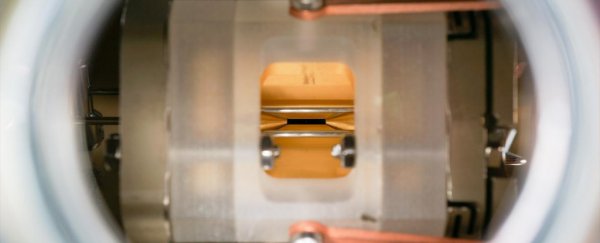Before it's observed, an electron is a hot mess of possibility. Just like the metaphorical Schrödinger's cat, it's only once we lift the lid from its metaphorical box and take a good, close look that an electron settles on a clear position around an atom.
We've now had a closer look at exactly how this settling happens. By taking a series of snapshots of a strontium ion held in an electric field, a team of physicists from Sweden, Germany and Spain have found an electron's transition from 'maybe' to 'reality' isn't quite an all or nothing affair.
For the better part of a century it's been fairly clear that the Universe we experience in our daily lives isn't quite like the one we see when we try to look at it up close.
One extraordinary consequence of the strangeness at the heart of physics is objects can only be described using sets of probabilities called superpositions - up until we poke them with probes and bombard them with light to determine for certain their size and nature.
In our classical world of absolutes, this is hard to picture. Even the famous physicist Erwin Schrödinger mocked the idea when he first heard it, posing a thought experiment involving an imagined cat that was at once alive and dead until we looked.
Only by opening the box and observing is the cat's potential life either sustained or extinguished, at least in the eyes of the observer.
Schrödinger found it silly, as did Einstein, but since then it's been shown time and time again that this metaphorical cat is indeed an accurate description of the way physics works.
One question that remains is whether there's such a thing as an ideal quantum measurement, one that can measure aspects of a system without causing its entire superposition to collapse into a final answer.
In the 1940s, the American-Hungarian mathematician John von Neumann figured that measuring one part of a quantum system – such as the position of an electron in an orbit – would create sufficient quantum noise to it all to give up its probabilistic nature.
Years later, a German theoretical physicist named Gerhart Lüders contested von Neumann's assumptions, pointing out that some undecided qualities of a particle's possibilities could stick around even while others become clear.
While physicists have agreed with Lüders in theory, it's not the easiest thing to demonstrate experimentally, relying on measuring certain actions that occur naturally in a way that they don't interfere with one another.
The researchers settled on an atom of strontium with missing electrons, trapping the ion in a way that makes it unclear which of two orbits the remaining electrons are in, leaving them in a smear of both.
It's more or less the same set-up used in many quantum computers. A laser then forces the superposition of electrons in the ion to move, with the potential shift in orbit confirmed by detecting the light that's emitted as the electron falls back into place.
Only on detection of the light can we consider the absolute position of the electron as locked in place.
"Every time when we measure the orbit of the electron, the answer of the measurement will be that the electron was either in a lower or higher orbit, never something in between," says Stockholm University physicist Fabian Pokorny.
"The measurement in a sense forces the electron to decide in which of the two states it is."
Capturing numerous photons as the strontium ion is rotated into different states with separate laser provided the team with a picture of the process's evolution as it took place over a span of a millionth of a second.
They found that the transition of the quantum system from maybe to actually isn't an absolute affair. Aspects of it can be measured, such as the final resting place of the electron, while leaving some features of its superposition untouched and undecided. Just as Lüders had argued.
"These findings shed new light onto the inner workings of nature and are consistent with the predictions of modern quantum physics", says lead researcher Markus Hennrich, also a physicist from Stockholm University.
What's more, this shift isn't instantaneous. By taking snapshots of the atom as one of its electrons adopts a clear orbit, the team showed the change is an unfolding one, as if the transition from complete uncertainty into a specific orbit is a matter of increasing probability, rather than a sudden decision.
This isn't the first experiment to show how quantum jumps in an electron's possibility is an unfolding process like "the eruption of a volcano", rather than a switch. But it does add some interesting details to the way this change occurs that allows for such ideal measurements.
Sadly none of this tells us what a transition of quantum possibilities into a clear measurement means in the grand scheme of things, let alone how to think of Schrödinger's poor cat as it waits patiently in the darkness.
All we know is lifting the lid on the poor animal doesn't rob it completely of its mystery. Even if it risks a slower death than von Neumann might have imagined.
This research was published in Physical Review Letters.
